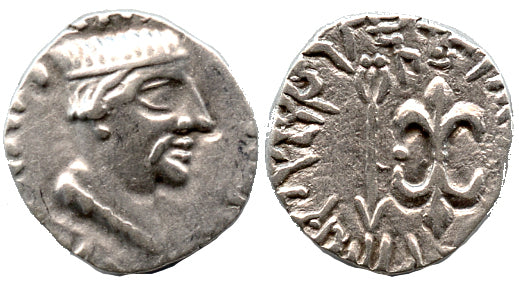
Bust of Nahapana right with collar showing, wearing a satrapal cap, corrupt Greek inscription: PANNIW CAHAPATAC NAHAPANAC // Arrow pointing downwards to the left, thunderbolt to the right, dot between them, two inscriptions - one in Brahmi (Rajno Ksaharatasa Nahapanasa, reading left to right) and one in Kharoshti (Rano Ksaharatasa Nahapanasa, reading right to left). 16mm, 2.2 grams. Fishman "The Silver Coinage of the Western Satraps in India" #3.4.
Nahapāna was a prominent ruler of the Western Kshatrapas, a dynasty of Saka (Indo-Scythian) origin that ruled parts of western and central India in the 1st–2nd centuries CE. He controlled a vast territory including parts of Maharashtra, Gujarat, Rajasthan, and Madhya Pradesh, and is well known through his extensive silver coinage and inscriptions, particularly those found in Nasik caves. Nahapāna's reign marked a period of prosperity, trade, and cultural integration, and he is often associated with the revival of urban centers and patronage of Buddhist institutions. However, his power came into conflict with the Satavahana dynasty, and he was eventually defeated by Gautamiputra Satakarni, a major Satavahana ruler. This defeat is recorded in a famous inscription at Nasik, marking the end of Nahapāna’s rule and the decline of Saka dominance in the Deccan. Despite his downfall, Nahapāna remains a significant figure for his role in the early historical development of peninsular India.
